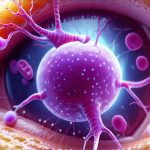The human body is often perceived as a self-contained unit, but it’s far more accurate to view us as ecosystems—complex communities teeming with life. This isn’t just metaphorical; trillions of microorganisms – bacteria, archaea, fungi, and viruses – reside within and on us, collectively known as the human microbiome. These microbial inhabitants aren’t merely passengers; they play a crucial role in nearly every aspect of our health, from digestion and immunity to mental wellbeing. Increasingly sophisticated research reveals that the diversity and composition of our microbiome are profoundly influenced by our environment, and specifically, by our interactions with nature, soil, and companion animals. Understanding this connection is unlocking new perspectives on preventative healthcare and holistic wellness.
For a long time, modern life has largely distanced us from these foundational elements, prioritizing sterile environments and minimizing contact with the ‘wild’ world. This shift, while offering certain protections, may inadvertently contribute to a diminished microbiome diversity, potentially increasing susceptibility to various health challenges. The rise in autoimmune diseases, allergies, and even mental health disorders is prompting scientists to explore what’s been lost – and how we can restore some of that essential microbial connection through deliberate exposure to the natural world. This isn’t about rejecting advancements; it’s about recognizing that our biology evolved in nature, not apart from it.
The Enriching Power of Natural Environments
Our ancestors lived in constant contact with a rich tapestry of microbes found in soil, plants, and water. Modern lifestyles, characterized by indoor living, sanitized surfaces, and antibiotic overuse, have drastically reduced this microbial exposure. This reduction isn’t necessarily bad – hygiene is important – but the extreme minimization can lead to what’s often called ‘microbiome impoverishment’. Natural environments offer a potent solution because they act as reservoirs of microbial diversity. Spending time outdoors exposes us to countless microorganisms that can colonize our skin, gut, and respiratory systems, bolstering overall microbiome health.
- Exposure to green spaces has been linked to increased alpha diversity, meaning greater variety within the microbial community.
- Specific microbes found in soil, such as Mycobacterium vaccae, have even demonstrated mood-boosting effects, potentially influencing the gut-brain axis.
- The ‘old friends’ hypothesis suggests our immune systems evolved alongside these environmental microbes and require ongoing exposure to function optimally.
This isn’t just about walking in a park; different natural environments offer unique microbial profiles. Forests, grasslands, coastal areas – each harbors distinct communities of microorganisms. Even the time of year can impact microbial diversity due to changes in plant life and weather patterns. Simply increasing our time spent outdoors, embracing a variety of natural settings, can have profound benefits for our microbiome. The key takeaway is that exposure to environmental microbes isn’t just about avoiding harmful pathogens; it’s about actively cultivating a diverse and resilient microbial ecosystem within ourselves.
Soil as a Microbial Reservoir
Soil is arguably the most microbe-rich environment on Earth. It contains an astonishing array of bacteria, fungi, archaea, and viruses—far exceeding the diversity found in our gut or on our skin. This vast microbial community isn’t isolated to the soil itself; wind currents, dust particles, and direct contact readily transfer these microbes to us. Gardening, playing outdoors, even simply walking barefoot on grass can all contribute to this microbial exchange. The benefits extend beyond mere exposure: certain soil bacteria produce compounds that support plant growth but also have immunomodulatory effects in humans, helping to regulate the immune system.
The concept of ‘dirt’ as something inherently negative is a relatively recent cultural construct. Historically, human civilizations thrived alongside close contact with soil and its microbial inhabitants. This close relationship likely played a role in developing robust immune systems and minimizing inflammatory responses. Modern sanitation practices have inadvertently created a disconnect from this ancestral connection.
Furthermore, the specific composition of soil microbes varies greatly depending on location and land management practices. Organic farming methods, for example, promote greater microbial diversity compared to conventional agriculture that relies heavily on pesticides and fertilizers. Choosing to engage with naturally managed landscapes—gardening organically, hiking in undisturbed areas—can maximize our exposure to beneficial soil microbes. This isn’t about eschewing modern conveniences; it’s about consciously incorporating practices that reconnect us with the microbial richness of the earth. How to rotate foods can also support soil health and diversity.
The Role of Companion Animals
Pets aren’t just companions; they act as vectors for microbial exchange, effectively bridging the gap between human and environmental microbiomes. Studies have shown that pet owners tend to have more diverse gut microbiomes compared to non-pet owners. This is partly due to the fact that pets bring microbes into the home environment – on their fur, paws, and even in their droppings (though appropriate hygiene practices are essential!). Dogs, in particular, have been shown to share specific microbial communities with their owners, potentially contributing to immune system development and regulation.
- Different types of pets contribute different microbes: dogs tend to introduce a wider range of environmental bacteria, while cats may introduce different fungal species.
- Early life exposure to pets appears especially beneficial for microbiome development in children, reducing the risk of allergies and asthma.
- The act of interacting with pets – petting, playing, walking – promotes physical activity and outdoor time, further enhancing microbial exposure.
However, it’s crucial to remember that pet ownership comes with responsibilities. Regular veterinary care, proper hygiene practices (such as handwashing), and responsible waste disposal are essential for maintaining both human and animal health. The goal isn’t simply to acquire a pet; it’s to cultivate a healthy relationship based on mutual respect and wellbeing. The microbial benefits of pet ownership are maximized when combined with responsible pet care. How dehydration in pets can also impact their microbiome, so ensuring proper hydration is crucial.
Restoring Microbial Balance: A Holistic Approach
Re-establishing a healthy microbiome isn’t about seeking out specific ‘probiotic’ strains in isolation; it’s about creating an environment that fosters microbial diversity and resilience. This requires a holistic approach that incorporates several key strategies. First, prioritize time spent outdoors – actively engaging with natural environments rather than just passively being present. Second, consider incorporating gardening or foraging into your lifestyle to increase direct contact with soil microbes. Third, if appropriate, thoughtfully integrate pet ownership into your life, understanding the associated responsibilities and benefits.
- Diet plays a crucial role: consuming a diverse range of plant-based foods provides prebiotic fibers that nourish beneficial gut bacteria.
- Reducing antibiotic use (when possible) helps to preserve microbiome diversity.
- Minimizing exposure to harsh chemicals and antibacterial products can also support microbial health. Meal timing impacts digestion, influencing the gut environment.
The concept of ‘rewilding’ our microbiomes – restoring the ancestral connection with environmental microbes – is gaining traction in preventative healthcare. This isn’t about rejecting modern medicine; it’s about recognizing that a healthy microbiome is foundational for overall wellbeing. It’s about embracing the interconnectedness between ourselves, the natural world, and the trillions of microorganisms that call us home. If you experience ongoing issues, understand acid exposure could be a factor.
The Future of Microbiome Research
Research into the human microbiome is still in its early stages, but the pace of discovery is accelerating. Advanced sequencing technologies are allowing scientists to identify previously unknown microbial species and unravel their complex interactions with the human body. One promising area of research involves identifying specific soil microbes that have therapeutic potential—potentially leading to novel treatments for autoimmune diseases or mental health disorders. Another key focus is understanding how environmental factors influence microbiome development in early life, paving the way for interventions that can promote long-term health.
Furthermore, personalized microbiome analysis is becoming increasingly accessible, allowing individuals to gain insights into their unique microbial profiles and tailor lifestyle choices accordingly. While caution is needed to avoid overinterpretation of results, these tools offer a valuable opportunity to understand the complex interplay between our microbiomes and overall wellbeing. The future of healthcare may well involve harnessing the power of the microbiome—and reconnecting with the natural world that sustains it. This requires a shift in perspective—from viewing microbes as enemies to recognizing them as essential allies in our pursuit of health and vitality. Gut acidity is also key to overall wellbeing.


















